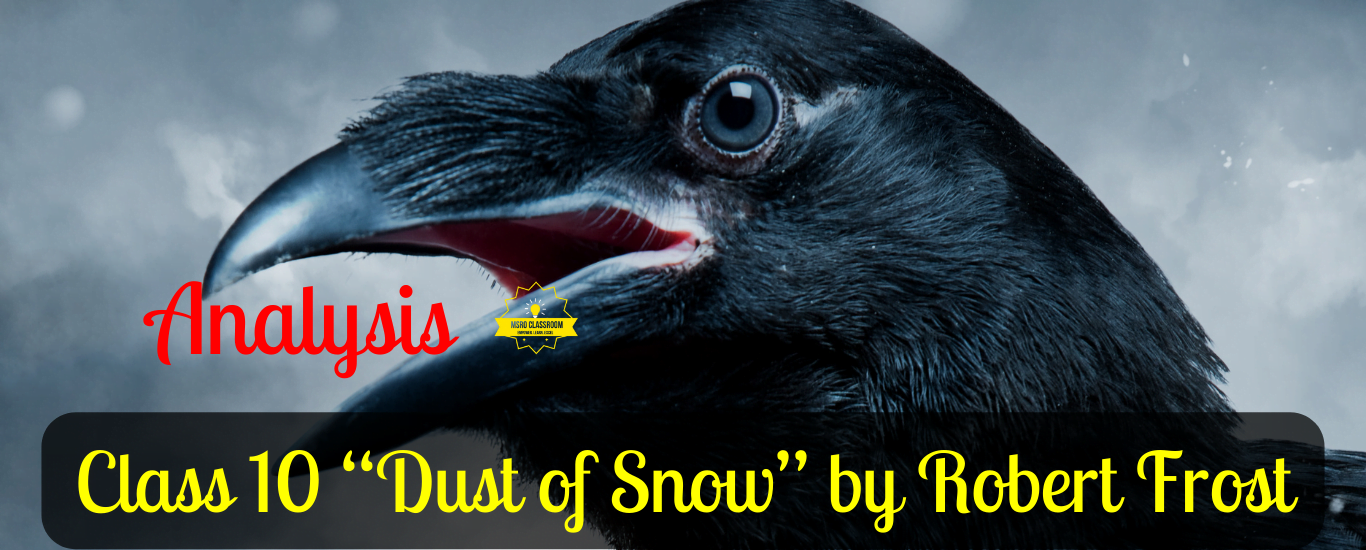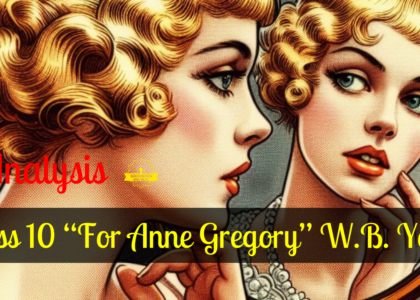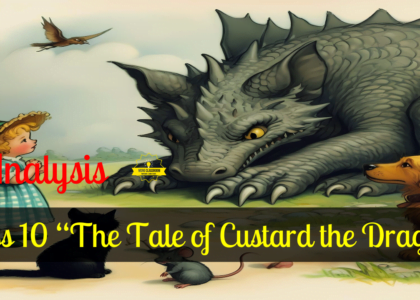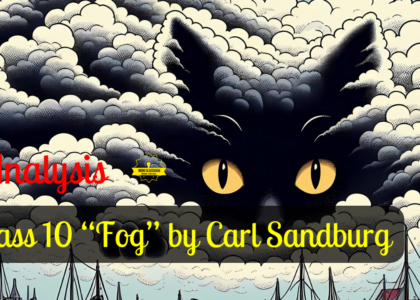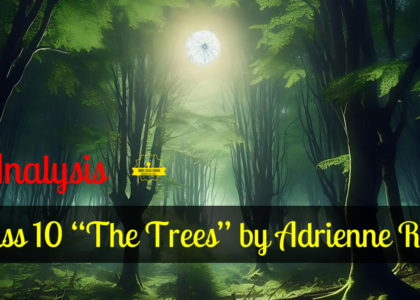Robert Frost’s ‘Dust of Snow’ Explanation with Summary, Extra Questions and Poetic Devices.
Poem 1- Dust of Snow by Robert Frost
Robert Frost
Robert Frost (1874-1963) was an esteemed American poet known for his profound exploration of nature and life’s complexities. His poetry, characterised by colloquial language and rhyming structures, captured the beauty and harshness of the New England landscape.
Dust of Snow’ was first published in “NEW HAMPSHIRE: A POEM WTH NOTES AND GRACE NOTES BY ROBERT FROST,” October 1923.
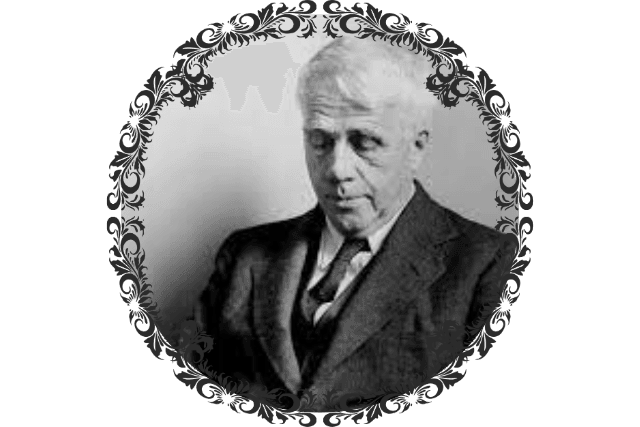
Table of Contents
Next on First Flight: ‘Fire And Ice‘ by Robert Frost, Also Read: Chapter 1 ‘A Letter to God‘ by G.L Fuentes, Chapter 2- Nelson Mandela
Summary “Dust of Snow”:
‘Dust of Snow’ by Robert Frost is a short and powerful poem that captures a transformative moment in nature. The poem illustrates the potential of small moments to shift one’s perspective and provide hope or solace. The “dust of snow” falling on the poet symbolises the little joys that can unexpectedly come into our lives. The poem serves as a reminder to appreciate life’s small things and find beauty and significance even in the most ordinary occurrences.
Central Idea: Dust of Snow
The central idea of “Dust of Snow” revolves around the transformative power of nature in uplifting the human spirit. In the poem, a seemingly mundane event – a crow shaking off snow from a hemlock tree – unexpectedly changes the narrator’s mood. The experience of the snow falling on the narrator is described as a burden, symbolising the weight of life’s troubles. However, the sudden interruption by the crow and the dust of snow it creates causes a shift in perspective. The simple, natural act of the crow becomes a catalyst for a profound change within the narrator, lifting their spirits and bringing a sense of renewal and clarity. Ultimately, the poem conveys the idea that even the smallest encounters with nature have the potential to inspire and rejuvenate us amidst life’s challenges.
Explanation “Dust of Snow”:
‘Dust of Snow’ is a short but impactful poem by Robert Frost, first published in 1923. It presents a simple yet profound moment of nature’s influence on human emotions and serves as a reminder of how small events can alter one’s perspective on life.
In just eight lines, Frost encapsulates a transformative experience. The poet recounts how a seemingly insignificant event – a crow shaking snow from a hemlock tree – unexpectedly affects his state of mind. The image of the crow, typically associated with darkness and gloom, contrasts with the pure white snow. This juxtaposition sets the stage for the poem’s central theme: the power of nature to influence human emotions and bring about a change in perspective.
The ‘dust of snow‘ falling on the poet symbolises the little joys or positive elements that can unexpectedly come into our lives, even amidst difficult or troubled times. The lightness of the snow contrasts with the heaviness of the poet’s earlier mood, illustrating the potential of small moments to shift one’s perspective and provide hope or solace.
The poem’s brevity and simplicity contribute to its impact. Frost’s choice of words is economical, yet each word carries weight and meaning. The poem serves as a reminder to appreciate life’s small things and find beauty and significance even in the most ordinary of occurrences.
‘Dust of Snow’ by Robert Frost is a reflective piece highlighting nature’s beauty and transformative power and how it can salvage a troubled day, leaving the reader with hope and renewed spirit.
Analysis “Dust of Snow”:
‘Dust of Snow’ is a short and poignant poem by Robert Frost that was published as part of his collection “New Hampshire: A Poem with Notes and Grace Notes.” Despite its brevity, the poem captures a significant moment of personal transformation and the impact of nature on the human psyche.
Title:
The title itself is straightforward and sets the scene for the poem. ‘Dust of Snow’ immediately brings to mind a winter landscape, with snow symbolising coldness, purity, and the passage of time.
Structure:
The poem consists of two quatrains, each with alternating lines of iambic tetrameter and iambic trimeter. The simple and rhythmic structure complements the concise nature of the poetry. The rhyme scheme is ABAB CDCD.
Themes ‘Dust of Snow’:
In Robert Frost’s poem ‘Dust of Snow,’ several themes emerge, reflecting the poet’s skill in capturing deeper meanings within a concise and evocative poem.
Some of the key themes explored in ‘Dust of Snow’ include:
- Nature’s Influence:
One of the poem’s prominent themes is nature’s transformative power. The poem illustrates how a seemingly ordinary and insignificant event, such as the dust of snow falling on the speaker’s head, can profoundly impact one’s emotions and perspective. Nature, represented by the crow, hemlock tree, and snow, catalyses change and renewal.
- Redemption and Renewal:
The poem conveys a sense of redemption and renewal. The dust of snow falling on the speaker is portrayed as a positive and purifying force that interrupts the speaker’s melancholy. It symbolises a small moment of grace that can unexpectedly lift one’s spirits and offer a new outlook on life, even in the face of negativity and despair.
- Contrast and Duality:
Frost contrasts the dark and gloomy imagery of the crow and hemlock tree with the snow’s light, refreshing dust. This contrast emphasises the theme of dualities in life—sorrow and joy, darkness and light—and how even the smallest positive element can counterbalance negativity
- Appreciation of Simple Pleasures:
The poem highlights the importance of appreciating simple moments of beauty and joy. It encourages readers to find happiness and solace in the little things that can unexpectedly brighten their day.
- Transient Nature of Emotions:
The poem suggests that emotions are transient and subject to change. The speaker’s mood shifts from despondency (sadness) to a sense of upliftment and hope through encountering nature’s dust of snow. It serves as a reminder that life’s emotional landscape is ever-changing.
- Acceptance of Imperfections:
The poem subtly reflects on the imperfections and burdens that everyone carries. By acknowledging these aspects of life, the poem suggests that finding moments of relief and redemption is possible.
Imagery:
Frost uses vivid imagery to depict a winter scene. The “crow” and “hemlock tree” represent elements of nature, while the “dust of snow” symbolises the light and delicate snowflakes falling from the tree. These images create a stark contrast between the dark, gloomy crow and the pure, refreshing snow.
Emotion and Mood:
The poem starts with a sense of heaviness and gloom, suggested by the presence of the crow and the hemlock tree. However, the mood dramatically shifts in the second quatrain when snow dust falls on the speaker. This event brings a sudden change in emotions.
Symbolism:
- The “crow” represents negativity, sorrow, or burden.
- The “hemlock tree” symbolises the weight of the world or feelings of desolation.
- The “dust of snow” embodies a small moment of joy, beauty, or hope.
(Check out our explanation video on MSRO CLASSROOM down below)
Meaning and Interpretation:
The poem captures a transformative moment in the speaker’s life. A crow shaking snow off a hemlock tree and the dust of snow falling on the speaker’s head leads to a change in mood. The dust of snow is a catalyst, breaking the cycle of negative emotions.
Poem’s Message:
The poem’s message is that even in the darkest moments of life, the beauty and simplicity of nature can offer solace and renewal. It reminds readers to be receptive to the small joys that can unexpectedly lift their spirits and change their outlook.
In conclusion, ‘Dust of Snow’ is a classic example of Robert Frost’s ability to find profound meaning in the seemingly ordinary and his skill in depicting the interplay between nature and human emotions. The brevity of the poem, combined with its powerful imagery and transformative message, makes it a memorable and timeless piece of poetry.
Line-by-Line Explanation “Dust of Snow”:
1. “The way a crow” The poem starts by setting the scene with the presence of a crow. Crows are often associated with negative symbolism, such as bad luck or sorrow.
2. “Shook down on me” The crow is depicted as shaking something down on the speaker. “me” indicates that the speaker receives whatever the crow is shaking.
3. “The dust of snow” The crow shakes down a “dust of snow.” This refers to the light and delicate snowflakes falling from the tree after the crow disturbs it. The snow is often associated with purity and beauty.
4. “From a hemlock tree” The snow is falling from a hemlock tree, a type of evergreen tree. Hemlock trees are typically associated with solitude and can symbolise desolation or gloom.
5. “Has given my heart” The falling snow has affected the speaker’s heart, symbolising their emotions and feelings.
6. “A change of mood” The falling dust of snow has caused a change in the speaker’s emotional state, leading to a shift in their mood or feelings.
7. “And saved some part” The snowfall has rescued or salvaged a part of the speaker’s day that was likely troubled or sorrowful.
8. “Of a day I had rued”. The speaker regretted or felt distressed about this particular day before encountering the dust of snow. The falling snow has now brought a sense of relief or redemption.
Questions Answers “Dust of Snow”:
Textbook Question Answers:
Q1: What is a “dust of snow”? What does the poet say has changed his mood? How has the poet’s mood changed?
A1: The phrase “dust of snow” symbolises a small, transformative moment that has a profound impact. The poet describes how a crow shakes the snow dust from a hemlock tree onto the speaker.
This seemingly insignificant event unexpectedly changes the poet’s mood. The light, powdery snow represents a cleansing or purifying force, as if nature has intervened to uplift the speaker’s spirits. The poet’s mood shifts from ruefulness, suggesting regret or sorrow, to a more positive and hopeful outlook.
The crow’s action and the descent of the dust of snow save a part of the poet’s day, suggesting that even the most minor encounters with nature can have a profound impact, bringing about a welcome change in perspective and emotional disposition.
Q2: How does Frost present nature in this poem?
i: What are the birds that are usually named in poems? Is a crow often mentioned in poems? What images come to your mind when you think of a crow?
Ai: Various birds are commonly mentioned in poems, each carrying symbolic and thematic significance. Some frequently named birds in poetry include:
- Nightingale: Known for its beautiful and melodious song, often symbolising love and beauty.
- Raven: Often associated with mystery and darkness, the raven can have positive and ominous connotations.
- Swan: Represents grace and beauty, often linked to love and transformation themes.
- Skylark: Symbolizes freedom and is often associated with the beauty of nature.
- Albatross: Carries a heavy symbolic burden, representing a curse or burden one must bear.
As for crows, they do appear frequently in poetry. Crows often have various symbolic meanings, including mystery, intelligence, transformation, and death. In literature, crows can evoke a sense of foreboding or serve as messengers between realms. The image of a crow can be both dark and enigmatic, contributing to a rich and diverse tapestry of poetic imagery.
ii: Again, what is “a hemlock tree”? Why doesn’t the poet write about a more ‘beautiful’ tree such as a maple, an oak, or a pine?
Aii: In ‘Dust of Snow,’ the term “hemlock tree“ refers to a coniferous tree from the Tsuga genus, known for evergreen needles and cones.
Deliberate Choice Over ‘Beautiful’ Trees:
- Frost intentionally chooses the hemlock over conventionally ‘beautiful’ trees like maple or oak.
- The poet often uses nature to convey deeper meanings.
Symbolism of Hemlock:
- The hemlock tree is associated with poison and danger, adding an intriguing layer of symbolism to the poem.
Contrast for Emphasis:
- The contrast between the potential negativity of the hemlock and the positive mood change caused by the dust of snow highlights the transformative power of small, unexpected moments in nature.
Connection to New Hampshire:
- The poem is part of the New Hampshire collection, reflecting Frost’s deep connection to the region.
- The hemlock tree is native to North America, specifically the New Hampshire, New England region where Frost spent much of his life.
Regional Authenticity:
- The hemlock adds a layer of regional authenticity, enhancing the vivid and realistic imagery characteristic of Frost’s works.
iii. What do the ‘crow’ and ‘hemlock’ represent — joy or sorrow? What does the dust of snow that the crow shakes off a hemlock tree stand for?
Aiii: In Robert Frost’s poem ‘Dust of Snow,’ the crow and the hemlock tree, as well as the dust of snow shaken off the tree, carry symbolic meanings:
Crow:
- In this context, the crow doesn’t represent joy or sorrow.
- Crows are often associated with mystery and intelligence in literature.
- In this poem, the crow’s action catalyses change rather than embodying a specific emotion.
Hemlock Tree:
- The hemlock tree, associated with poison and danger, introduces an intriguing layer of symbolism.
- Its selection of conventionally ‘beautiful’ trees might symbolise unexpected sources of inspiration in unlikely or potentially negative places.
Dust of Snow:
- The dust of snow shaken off the hemlock tree symbolises a small, transformative moment in nature.
- It represents the positive change in the poet’s mood.
- Despite the potential negativity associated with the hemlock, the dust of snow catalyses joy, suggesting that even seemingly adverse circumstances can lead to uplifting experiences.
In summary, the crow and hemlock tree don’t directly represent joy or sorrow but contribute to a nuanced and transformative moment symbolised by snow dust, positively changing the poet’s mood.
Extra Questions “Dust of Snow”:
Q1: What is the central theme of the poem ‘Dust of Snow’ by Robert Frost?
A1: The poem’s central theme is the transformative power of nature and how even the most minor and unexpected moments in nature can significantly impact our emotions and outlook on life.
Q2: What does the crow symbolise in the poem?
A2: The crow symbolises negativity, sorrow, or burden. It sets the initial tone of the poem as something gloomy or troubled.
Q3: What does the poem’s “dust of snow” represent?
A3: The “dust of snow” represents a moment of joy, beauty, or hope. It is a positive and purifying force that interrupts the speaker’s negative emotions caused by the crow and the hemlock tree.
Q4: How does the encounter with the dust of snow change the speaker’s mood?
A4: The falling dust of snow changes the speaker’s mood by bringing a sudden upliftment and sense of renewal. It rescues a part of the speaker’s day that had been troubled or rued, providing a positive shift in their perspective.
Q5: What is the message of the poem?
A5: The poem’s message is that even in the darkest moments of life, the beauty and simplicity of nature can offer solace and redemption. It encourages readers to be receptive to the small joys that can unexpectedly brighten their day and change their emotional state.
Q6: What is the significance of the hemlock tree in the poem ‘Dust of Snow’?
A6: The hemlock tree in the poem symbolises desolation or gloom. Its presence and the crow set a negative and sombre tone at the poem’s beginning. However, the falling dust of snow from the hemlock tree later catalyses a positive change in the speaker’s mood.
Q7: How does Robert Frost use imagery to convey the poem’s atmosphere?
A7: Frost uses vivid imagery of the crow, hemlock tree, and dust of snow to create a winter landscape and convey a sense of heaviness and gloom. The contrasting images of the dark crow and the pure snowflakes falling from the hemlock tree help set the stage for the transformative moment when the dust of snow changes the speaker’s mood.
Q8: Why do you think the speaker refers to snow dust as “saved some part / Of a day I had rued”?
A8: The speaker refers to the dust of snow as “saved some part” because it has redeemed or salvaged a portion of the day that the speaker had previously regretted or felt distress about. The encounter with the dust of snow positively changes the speaker’s emotions and offers a fresh perspective on the day’s events.
Q9: How does the brevity of the poem contribute to its impact?
A9: The poem’s brevity contributes to its impact by focusing on a single transformative moment, making it concise yet powerful. The poem’s simplicity and succinctness enhance the potency of the message, showing how a small, unexpected act of nature can significantly change one’s emotional state.
Q10: What can we learn from ‘Dust of Snow’ about finding beauty in everyday experiences?
A10: ‘Dust of Snow’ teaches us that finding beauty in everyday experiences can profoundly affect our outlook and emotions. Despite the presence of negativity represented by the crow and the hemlock tree, the simple and pure dust of snow falling on the speaker’s head serves as a reminder to appreciate the small joys and simple pleasures that nature can offer, even during challenging times. It encourages us to find moments of solace and redemption in the seemingly ordinary occurrences of life.
Extract-Based Questions “Dust of Snow“:
Extract 1:
“The way a crow
Shook down on me
The dust of snow
From a hemlock tree”
Q1: How does the crow’s action in the poem ‘Dust of Snow’ impact the speaker’s surroundings?
A1: The crow’s action of shaking down the dust of snow from a hemlock tree changes the speaker’s environment.
Q2: What imagery is depicted when the crow shakes the snow from the hemlock tree in ‘Dust of Snow’?
A2: The crow’s action creates an image of snow falling like dust from the tree, as described in the poem’s first stanza.
Q3: In the first stanza of’ Dust of Snow, ‘ how does the poet portray the impact of a crow’s action, and what imagery describes the event?
A3: In the first stanza of ‘Dust of Snow,’ the poet vividly describes how a crow’s actions profoundly affect the speaker’s mood. The crow shakes down the dust of snow from a hemlock tree onto the speaker, creating an unexpected moment of beauty and transformation. This simple act of nature symbolises a shift in the speaker’s perspective, highlighting the power of small moments to alter our emotions. The imagery of snow falling like dust from the tree creates a delicate yet impactful visual, highlighting that even the most minor encounters with nature can have a lasting impact on our emotions and outlook.
Q4: How does Robert Frost employ the imagery of the crow and the falling snow in the first stanza of ‘Dust of Snow’ to convey a deeper meaning, and how does this scene relate to the broader themes in the poem?
A4: In the first stanza of ‘Dust of Snow,’ Frost skillfully uses the imagery of a crow shaking snow from a hemlock tree to symbolise unexpected moments of transformation. This seemingly ordinary event is a metaphor for the impact of minor, unplanned occurrences on our emotional state. It demonstrates how nature has the power to alter human perspectives and moods. This scene connects to the poem’s overarching themes of finding beauty in everyday experiences and the potential for even mundane encounters to evoke profound change in our outlook.
Extract 2:
“Has given my heart
A change of mood
And saved some part
Of a day I had rued.”
Q1: How does the speaker’s mood shift due to the crow’s action in ‘Dust of Snow’?
A1: As stated in the second stanza, the crow’s action transforms the speaker’s mood positively.
Q2: How does the crow’s action impact the speaker’s perception of the day in the poem ‘Dust of Snow’?
A2: The crow’s action changes the speaker’s perspective on a regrettable day, imparting a sense of redemption and relief, as depicted in the poem’s second stanza.
Q3: How does the phrase “saved some part of a day I had rued” reflect the significance of the crow’s action in ‘Dust of Snow’?
A3: The phrase implies that the crow’s action salvages a portion of a regretful day, suggesting that even small moments can hold meaning and redemption.
Q4: How does the second stanza of ‘Dust of Snow’ by Robert Frost explore the emotional significance of the crow’s action, and what does it suggest about the speaker’s experience of the day?
A4: The second stanza of ‘Dust of Snow’ delves into the emotional aftermath of the crow’s action. The speaker describes how the crow’s seemingly insignificant gesture has brought about a shift in their mood. The crow’s action has given the speaker’s heart a positive change, rescuing a part of a day that the speaker had previously regretted. This stanza reflects on the idea that even a minor event, like the dust of snow shaken by a crow, can profoundly impact one’s emotional state. It suggests that even amid challenges or negative experiences, there are moments of beauty and redemption that can alter our perception of the day and bring about a sense of renewal.
Q5: How does the second stanza of Robert Frost’s ‘Dust of Snow’ delve into the concept of redemption and emotional renewal, and how does it contribute to the poem’s exploration of the connection between nature and human experience?
A5: In the second stanza of ‘Dust of Snow,’ Frost explores the idea of redemption and emotional transformation. The speaker’s heart undergoes a positive shift in mood due to the crow’s action, leading to the rescue of a portion of a regrettable day. This stanza highlights the capacity of even minor occurrences to mitigate negative feelings and contribute to a sense of renewal. Furthermore, it reinforces the theme of nature’s influence on human emotions, suggesting that the natural world can offer solace and redemption, even in distress. This interplay between nature and human experience is central to the poem’s message of finding comfort and beauty in unexpected places.

